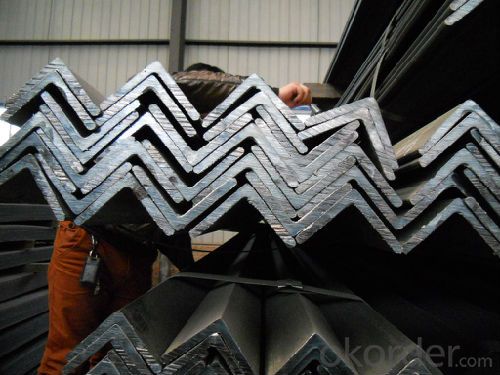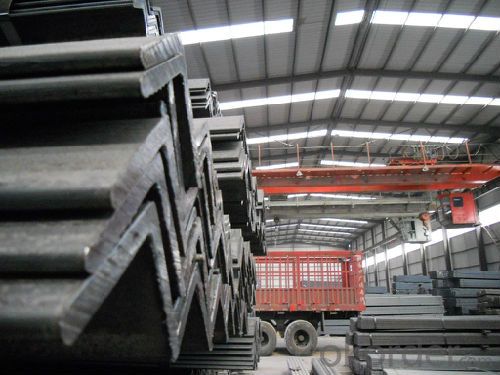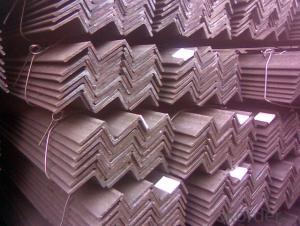Unequal Galvanized Angle Steel 65*65*6mm ASTM/A36/ SS540
- Loading Port:
- Tianjin
- Payment Terms:
- TT or LC
- Min Order Qty:
- 30 m.t.
- Supply Capability:
- 40000 m.t./month
OKorder Service Pledge
OKorder Financial Service
You Might Also Like
Product Description:
OKorder is offering Unequal Galvanized Angle Steel 65*65*6mm ASTM/A36/ SS540 at great prices with worldwide shipping. Our supplier is a world-class manufacturer of steel, with our products utilized the world over. OKorder annually supplies products to European, North American and Asian markets. We provide quotations within 24 hours of receiving an inquiry and guarantee competitive prices.
Product Applications:
Unequal Galvanized Angle Steel 65*65*6mm ASTM/A36/ SS540 are ideal for structural applications and are widely used in the construction of buildings and bridges, and the manufacturing, petrochemical, and transportation industries.
Product Advantages:
OKorder's Unequal Galvanized Angle Steel 65*65*6mm ASTM/A36/ SS540 are durable, strong, and resist corrosion.
Main Product Features:
· Premium quality
· Prompt delivery & seaworthy packing (30 days after receiving deposit)
· Corrosion resistance
· Can be recycled and reused
· Mill test certification
· Professional Service
· Competitive pricing
Product Specifications:
1.Variety:equal ,unequal
2.standard:GB/1220-92 AISI ASTM JIS DIN
3.Size: 20mm*20mm*3mm - 250mm*250mm*35mm
4.MOQ:50MT
5.Weight: theoretical weight or actual net weight at buyer's option
6.Mill: qualified Chinese steel mills
7.Packing: mill's standard packing
8.Payment: L/C, T/T
Grade | |||||||
| Q235/Q345/SS400/ST37-2/ST50/Q420/Q460 | |||||||
General Specification: | |||||||
Size (mm) | Weight (kg/m) | Size (mm) | Weight (kg/m) | Size (mm) | Weight (kg/m) | Size (mm) | Weight (kg/m) |
25*3 | 1.124 | 70*5 | 5.397 | 100*6 | 9.366 | 70*45*4 | 3.57 |
25*4 | 1.459 | 70*6 | 6.406 | 100*8 | 12.276 | 70*45*5 | 4.403 |
30*3 | 1.373 | 70*7 | 7.398 | 100*10 | 15.12 | 70*45*6 | 5.218 |
30*4 | 1.786 | 70*8 | 8.373 | 100*12 | 17.898 | 100*80*6 | 8.35 |
40*3 | 1.852 | 75*5 | 5.818 | 110*8 | 13.532 | 100*80*7 | 9.656 |
40*4 | 2.422 | 75*6 | 6.905 | 110*10 | 16.69 | 100*80*8 | 10.946 |
40*5 | 2.976 | 75*7 | 7.976 | 110*12 | 19.782 | 110*70*8 | 10.946 |
50*4 | 3.059 | 75*8 | 9.03 | 110*14 | 22.809 | 110*70*10 | 13.476 |
50*5 | 3.77 | 75*10 | 11.089 | 125*8 | 15.504 | 140*90*8 | 14.16 |
50*6 | 4.465 | 80*6 | 7.376 | 125*10 | 19.133 | 140*90*10 | 17.475 |
60*5 | 4.57 | 80*8 | 9.658 | 125*12 | 22.696 | 140*90*12 | 20.724 |
60*6 | 5.42 | 80*10 | 11.874 | 125*14 | 26.193 | 160*100*12 | 23.592 |
63*5 | 4.822 | 90*8 | 10.946 | 140*10 | 21.488 | 160*100*14 | 27.247 |
63*6 | 5.721 | 90*10 | 13.476 | 140*12 | 200*125*12 | 29.761 | |
63*8 | 7.469 | 90*12 | 15.94 | 200*125*14 | 34.436 | ||
FAQ:
Q1: Why buy Materials & Equipment from OKorder.com?
A1: All products offered byOKorder.com are carefully selected from China's most reliable manufacturing enterprises. Through its ISO certifications, OKorder.com adheres to the highest standards and a commitment to supply chain safety and customer satisfaction.
Q2: How do we guarantee the quality of our products?
A2: We have established an advanced quality management system which conducts strict quality tests at every step, from raw materials to the final product. At the same time, we provide extensive follow-up service assurances as required.
Q3: How soon can we receive the product after purchase?
A3: Within three days of placing an order, we will begin production. The specific shipping date is dependent upon international and government factors, but is typically 7 to 10 workdays.



- Q:Are steel angles affected by vibration?
- Yes, steel angles can be affected by vibration. When subjected to constant or repetitive vibrations, steel angles can experience fatigue or stress cracking over time. This is because vibrations, especially those of high frequency or amplitude, can induce dynamic loads on the steel angles. These loads can lead to cyclic stresses and strains, which can eventually cause damage to the material. In some cases, excessive vibrations can also cause the steel angles to resonate, resulting in amplified oscillations that can lead to structural failure. It is important to note that the susceptibility of steel angles to vibrations depends on various factors such as the quality and strength of the steel, the magnitude and frequency of vibrations, and the design and installation of the structure. To mitigate the effects of vibration on steel angles, engineers and designers often employ various techniques such as damping systems, vibration isolation, or reinforcing the structure to increase its resistance to dynamic loads. Regular inspections and maintenance are also crucial to identify and address any potential issues caused by vibrations to ensure the structural integrity and longevity of steel angles.
- Q:Are steel angles suitable for rooftop installations?
- Yes, steel angles are suitable for rooftop installations. Steel angles are commonly used in construction for their strength and durability. They are particularly useful for rooftop installations due to their ability to provide structural support and stability. Steel angles can be used to secure various rooftop equipment such as solar panels, HVAC units, communication antennas, and satellite dishes. Additionally, steel angles are resistant to weathering, corrosion, and fire, making them a reliable choice for rooftop installations.
- Q:Can steel angles be used in window frames?
- Yes, steel angles can be used in window frames. Steel angles are commonly used in construction and can provide structural support and stability to window frames. They are often used as reinforcements or brackets to connect the window frame to the wall or to other components of the window system. Steel angles are durable, strong, and resistant to corrosion, making them a suitable choice for window frame construction. Additionally, steel angles can be easily customized and fabricated to fit different window sizes and designs.
- Q:Can steel angles be used as support brackets?
- Yes, steel angles can be used as support brackets. They are commonly used in construction and engineering projects to provide structural support and stability. Steel angles offer strength and durability, making them suitable for supporting various loads and reinforcing structures.
- Q:Are steel angles suitable for load-bearing walls in residential buildings?
- Yes, steel angles are suitable for load-bearing walls in residential buildings. Steel angles are commonly used in construction due to their high strength and durability. They are capable of supporting heavy loads and can provide stability to the structure. Additionally, steel angles can be easily installed and are cost-effective compared to other building materials. They are also fire-resistant, which is an important factor for ensuring the safety of residential buildings. Overall, steel angles are a reliable choice for load-bearing walls in residential buildings.
- Q:What is angle iron?
- Widely used in a variety of architectural and engineering structures, such as beams, bridges, towers, hoisting and conveying machinery, ships, industrial furnace, reaction tower, container rack and warehouse shelves, also used to protect column, wall parts easy to hit. Depending on the structure, a variety of different force components are needed, and they can also be used as connecting pieces between components.
- Q:What are the different design considerations for steel angles in architectural applications?
- When it comes to using steel angles in architectural applications, there are several design considerations that need to be taken into account. These considerations include the load-bearing capacity of the angles, their structural integrity, aesthetics, and overall design flexibility. One of the primary design considerations for steel angles in architectural applications is their load-bearing capacity. Steel angles are often used to provide structural support in buildings, so it is crucial to ensure that they can withstand the anticipated loads. This involves calculating the maximum load that the angles will need to bear and selecting angles with the appropriate size and thickness to handle these loads safely. Another important consideration is the structural integrity of the steel angles. Architects and engineers need to consider factors such as the angle's resistance to bending, buckling, and shear. The design should take into account the angle's ability to distribute the loads evenly, minimizing the risk of failure or deformation. Aesthetics also play a significant role in architectural design, and steel angles can contribute to the overall visual appeal of a building. Architects may choose to incorporate angles with different profiles, finishes, or decorative elements to enhance the design and create a visually appealing structure. The angles should complement the overall architectural style and blend seamlessly with other building materials. Design flexibility is another crucial consideration when using steel angles. Architects often require angles that can be easily customized or fabricated to meet their specific design requirements. Steel angles can be cut, welded, or bent to create unique shapes and angles, allowing for creative architectural solutions. Lastly, it's important to consider the material properties and corrosion resistance of the steel angles. Architects need to evaluate the environmental conditions of the project site and select angles that can withstand exposure to moisture, chemicals, or other corrosive agents. Proper coatings or treatments can be applied to protect the angles from corrosion and ensure their longevity. In conclusion, the design considerations for steel angles in architectural applications encompass load-bearing capacity, structural integrity, aesthetics, design flexibility, and corrosion resistance. By carefully considering these factors, architects can select steel angles that meet both the functional and visual requirements of their projects, resulting in safe, durable, and visually appealing architectural structures.
- Q:What are the different surface finishes available for steel angles?
- Steel angles can be finished in various ways, depending on their intended use and desired appearance. Here are some common surface finishes for steel angles: 1. The mill finish is the standard, smooth finish that comes directly from the mill. It is a basic finish that is often chosen when appearance is not a major concern. 2. Hot-dip galvanizing involves immersing the steel angles in molten zinc to create a protective coating. This finish is ideal for outdoor or high-moisture environments due to its excellent corrosion resistance. 3. Powder coating is applied electrostatically as a dry powder, which is then cured under heat. It offers a durable and visually appealing finish, with a wide range of colors and textures to choose from. 4. Painting is another option, and different types of paint like epoxy, enamel, or acrylic can be used. Painting adds an extra layer of protection against corrosion and allows for customization in terms of color and appearance. 5. Stainless steel angles are inherently corrosion-resistant and commonly used in applications where hygiene, durability, and aesthetics are important, such as in food processing or architectural projects. 6. Shot blasting involves propelling small steel shots at high velocity onto the surface of the angles. This process removes mill scale, rust, and impurities, resulting in a clean and roughened surface that enhances adhesion for subsequent coatings or paints. These examples highlight the different surface finishes available for steel angles. The choice of finish depends on factors such as the intended use, environmental conditions, desired appearance, and budget. It is advisable to consult with a steel supplier or manufacturer to determine the most suitable surface finish for a specific application.
- Q:Are steel angles resistant to wind loads?
- Yes, steel angles are generally resistant to wind loads due to their high strength and structural integrity.
- Q:How can steel angles be cut to size?
- There are various methods available for cutting steel angles to size, depending on the tools and equipment that are accessible. One common approach involves utilizing a power saw equipped with a metal cutting blade. This particular saw allows for clean and precise cuts, enabling accurate sizing of the steel angles. Another option involves using an angle grinder with a cutting wheel attachment. This handheld tool can be easily maneuvered to cut through the steel angles, although the resulting cut may not be as clean as that achieved with a power saw. For smaller and thinner steel angles, a hacksaw can also be utilized. Although this manual tool requires more effort, it can still deliver accurate cuts. Furthermore, certain fabrication shops may possess more specialized cutting equipment, such as a plasma cutter or a water jet cutter, which offer even greater precision and efficiency. Ultimately, the choice of method for cutting steel angles to size will depend on the specific requirements and available resources.
1. Manufacturer Overview |
|
|---|---|
| Location | |
| Year Established | |
| Annual Output Value | |
| Main Markets | |
| Company Certifications | |
2. Manufacturer Certificates |
|
|---|---|
| a) Certification Name | |
| Range | |
| Reference | |
| Validity Period | |
3. Manufacturer Capability |
|
|---|---|
| a)Trade Capacity | |
| Nearest Port | |
| Export Percentage | |
| No.of Employees in Trade Department | |
| Language Spoken: | |
| b)Factory Information | |
| Factory Size: | |
| No. of Production Lines | |
| Contract Manufacturing | |
| Product Price Range | |
Send your message to us
Unequal Galvanized Angle Steel 65*65*6mm ASTM/A36/ SS540
- Loading Port:
- Tianjin
- Payment Terms:
- TT or LC
- Min Order Qty:
- 30 m.t.
- Supply Capability:
- 40000 m.t./month
OKorder Service Pledge
OKorder Financial Service
Similar products
New products
Hot products
Hot Searches
Related keywords


























